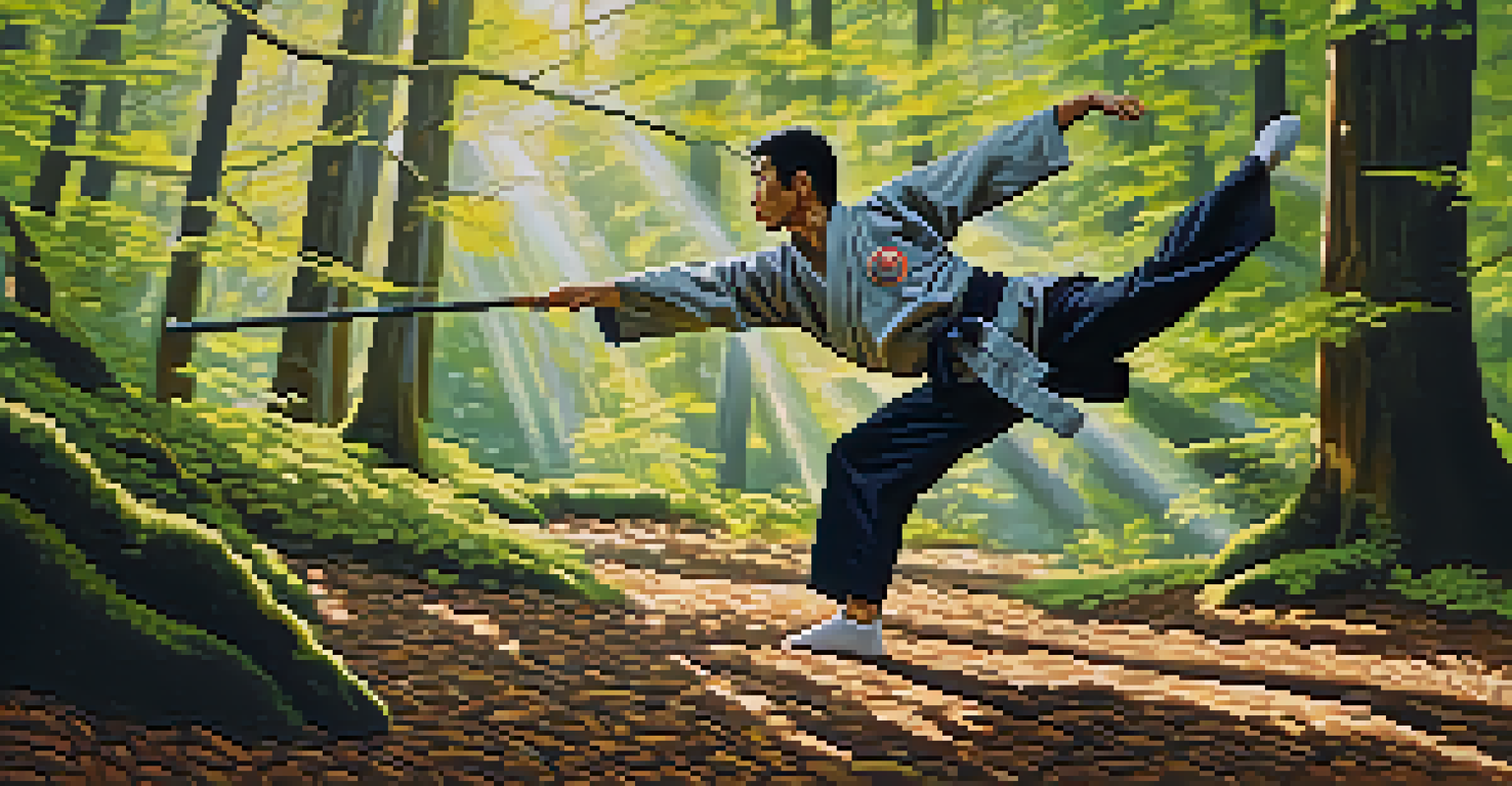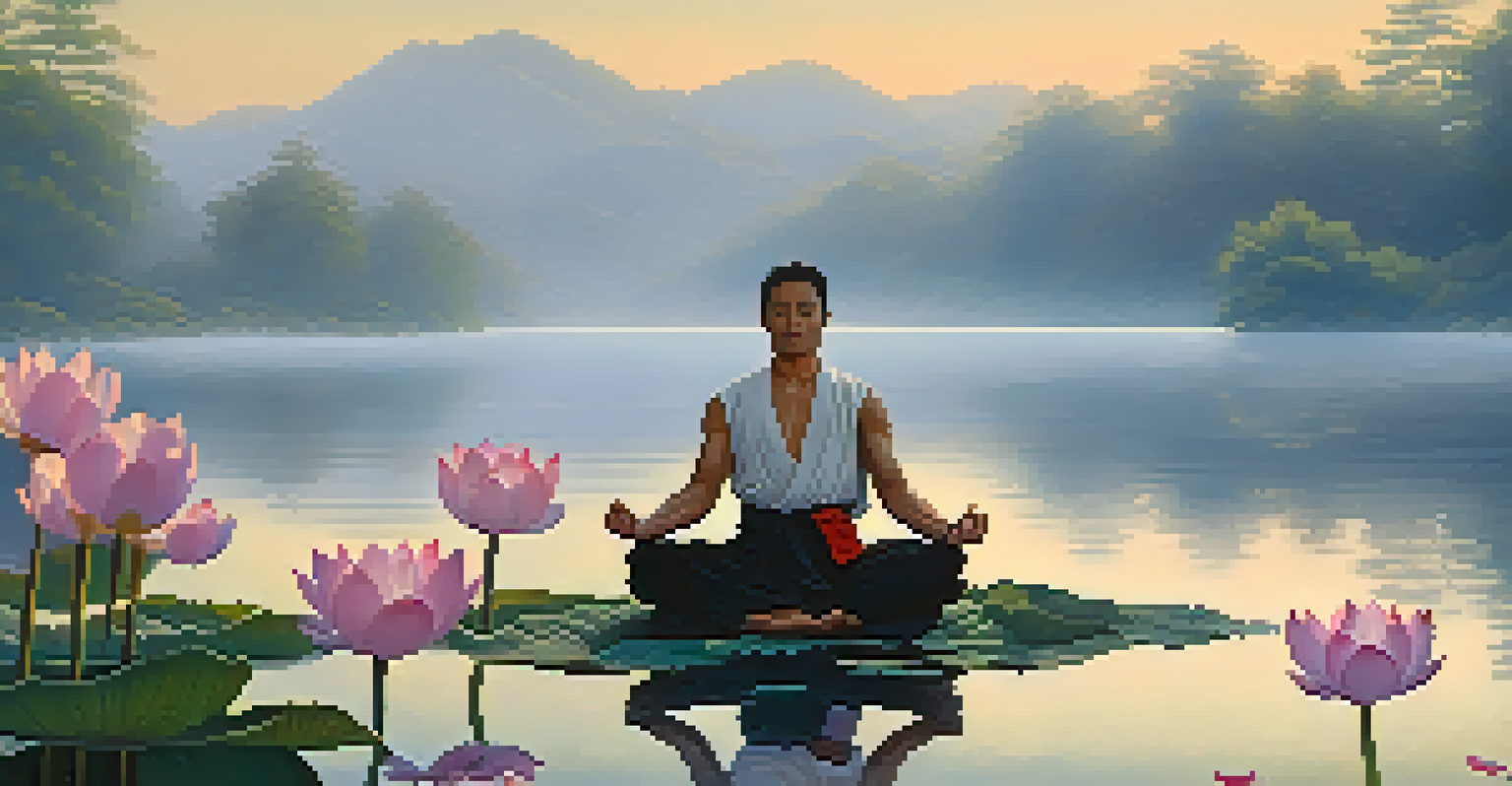Nature's Influence on Martial Arts Techniques and Styles

The Connection Between Nature and Martial Arts
Martial arts often draw inspiration from nature, mirroring its movements and philosophies. Many styles, such as Tai Chi, reflect the fluidity of water and the strength of mountains. This connection not only enhances physical techniques but also encourages a deeper understanding of balance and harmony inherent in nature.
Martial arts is not about fighting; it’s about finding your balance with the world around you.
Incorporating nature into martial arts practices fosters a sense of grounding and awareness. Practitioners learn to flow with their environment, adapting their techniques like a tree bending with the wind. This adaptability is essential in both training and real-life situations, promoting resilience and creativity.
Moreover, the principles found in nature, such as patience and perseverance, resonate deeply within martial arts. Just as a seed takes time to grow into a strong tree, martial artists must cultivate their skills and mindset over time. This journey reflects the natural processes around us, emphasizing growth and personal development.
Animal Styles and Their Natural Inspirations
Many martial arts styles are directly inspired by animals, showcasing their unique movements and characteristics. For instance, Kung Fu has various animal forms, such as the Tiger, Crane, and Snake, each representing different fighting techniques and philosophies. This mimicry allows practitioners to embody the essence of these creatures, enhancing their skills.

The agility and grace of the Crane teach practitioners about balance and precise movements, while the power of the Tiger emphasizes strength and aggression. By studying these animals, martial artists can adapt their strategies and techniques to fit their own strengths and weaknesses. It’s like taking a page from nature’s playbook to improve one’s game.
Nature Inspires Martial Arts Techniques
Many martial arts styles draw inspiration from nature, using its movements and philosophies to enhance physical techniques and foster balance.
Moreover, these animal-inspired techniques highlight the importance of being aware of one’s surroundings. Just as animals are attuned to their environment for survival, martial artists must cultivate this awareness to anticipate and respond to opponents. This connection further solidifies the bond between nature and martial arts.
Elements of Nature in Combat Techniques
The four classical elements—earth, water, fire, and air—play a pivotal role in shaping martial arts techniques. Each element embodies unique qualities that can be applied to combat, such as the stability of earth, the fluidity of water, the intensity of fire, and the agility of air. Understanding these elements allows practitioners to harness their respective strengths.
In nature, nothing is perfect and everything is perfect. Trees can be contorted, bent in weird ways, and they're still beautiful.
For example, the earth element represents grounding and stability, encouraging martial artists to adopt strong stances and rooted movements. In contrast, water symbolizes adaptability, teaching practitioners to flow with their opponent's energy rather than resisting it. This elemental approach adds depth and flexibility to combat strategies.
Additionally, the fire element can inspire techniques that require explosive power and aggression, while air emphasizes speed and evasion. By integrating these elements into their practice, martial artists can develop a well-rounded skill set that adapts to various fighting styles and scenarios.
Nature as a Training Ground for Martial Artists
Training in natural environments can significantly enhance martial arts practice. Outdoor settings, such as parks or mountains, provide diverse terrains that challenge practitioners physically and mentally. This shift from traditional dojos to nature helps cultivate adaptability and resilience, much like the environment itself.
Practicing in nature encourages martial artists to connect with their surroundings, fostering mindfulness and focus. The sounds of rustling leaves or flowing water can create a serene atmosphere, allowing for deeper concentration during training. This connection with nature can lead to a heightened sense of awareness and clarity, both on and off the mat.
Mindfulness Connects Nature and Practice
Practicing mindfulness in natural settings helps martial artists cultivate awareness, resilience, and a deeper connection to their environment.
Moreover, natural elements can serve as tools for building strength and agility. Trees can be used for balance exercises, while uneven terrain can improve footwork and stability. Embracing the outdoors not only enriches training but also nurtures a sense of respect for the environment and its influence on martial arts.
Mindfulness and Nature in Martial Arts Philosophy
Mindfulness is a core principle in many martial arts, deeply intertwined with the philosophies of nature. Practitioners are encouraged to be present, focusing on their breath and movements, much like the tranquility found in natural settings. This mindful approach fosters clarity and intention in both training and daily life.
Nature often embodies cycles of growth, decay, and renewal, mirroring the martial artist's journey. Embracing these natural cycles can teach valuable lessons about patience, resilience, and humility. Just as nature requires time to flourish, martial artists must understand that mastery comes through consistent practice and self-reflection.
Furthermore, engaging in mindfulness practices, such as meditation or breathing exercises, can enhance martial arts performance. By cultivating a calm mind and heightened awareness, practitioners can better respond to challenges and opponents. This synergy between nature, mindfulness, and martial arts cultivates a holistic approach to personal development.
Cultural Expressions of Nature in Martial Arts
Different cultures express their connection to nature through unique martial arts styles and practices. For instance, Japanese martial arts like Aikido emphasize harmony with the environment, reflecting the principles of nature in their techniques. This cultural expression showcases how local ecosystems shape martial arts philosophies and methods.
In contrast, Brazilian Jiu-Jitsu illustrates adaptability and flow, echoing the dynamic nature of its originating environment. The emphasis on ground fighting techniques mirrors the fluidity of water, allowing practitioners to navigate their surroundings effectively. This cultural lens highlights the diverse ways in which nature influences martial arts across the globe.
Cultural Expressions Reflect Nature
Different martial arts styles showcase unique cultural expressions of nature, emphasizing adaptability and respect for the environment.
These cultural expressions not only enrich martial arts but also promote a deeper appreciation for the environment. Practitioners learn to respect and honor the natural world, fostering a sense of responsibility toward its preservation. Ultimately, this connection enhances the overall martial arts experience, bridging the gap between culture, nature, and personal growth.
The Future of Martial Arts and Nature's Role
As martial arts evolve, the relationship with nature continues to grow in significance. Modern practitioners are increasingly recognizing the importance of incorporating natural elements into their training and philosophies. This shift not only enhances physical techniques but also nurtures a more profound connection to the environment.
Sustainability and eco-conscious practices are becoming more prevalent in martial arts communities. From outdoor training sessions to eco-friendly martial arts gear, practitioners are making strides toward aligning their practices with environmental stewardship. This evolution reflects a broader understanding of the interconnectedness between martial arts and nature.

Ultimately, the future of martial arts may very well hinge on this relationship with nature. As practitioners continue to explore and embrace the natural world, they will likely discover new techniques, philosophies, and ways to enhance their practice. This journey promises to deepen the connection between martial arts and the environment, fostering a more harmonious existence.